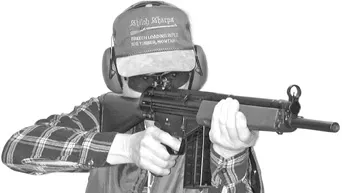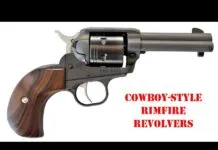
The Germans came up with a roller-locked weapon system near the close of WWII, but the close of that war took the design, and perhaps some of the designers, to Spain, where the first issue of the rifle was called the CETME Model 58. This had good success, and following the war the German firm of Heckler & Koch brought out its G3 based on that system, in a variety of calibers but primarily in .308. This was followed some time later by a semiautomatic version labeled the HK-91. The system is adaptable to a variety of calibers. H&K’s famous MP-5 in 9mm is favored by SWAT teams the world over. Roller locking has also been seen in some handguns, notably the Czech CZ-52, which we examined on these pages in September 2002.
In a nutshell, the bolt is operated by the force of the fired cartridge, which simply blows the bolt rearward. Bolt motion is retarded by the locking rollers, during the time it takes for them to unlock from the receiver. The bolt starts to move before the bullet has gone very far and when chamber pressure is still high. The cartridge case is freed to move by permitting gases to leak around the outside of the case in small grooves cut in the chamber. If this were not done, the case would be torn in two by the moving bolt. The ejected cases show the marks of the grooves and are also usually blackened to some extent. Though thoroughly proven, the system has at least one drawback in the form of relatively sharp recoil.
We test here three versions of roller-locked rifles now being made in the U.S., in three calibers. We look at the .308 PRT-91 from JLD Enterprises, the Vector Arms V-53 in .223, and Bobcat Weapons’ BW-5, in 9mm. Are they all suitable, and do they work? Let’s find out.
[PDFCAP(1)]
First up in our test is a close copy of the original HK-91 rifle. Our copy had dark-green furniture (buttstock, forend, and grip) and looked just great. All the PTR-91’s features and contours were very familiar to one of our test staff. He used to own two of this rifle type, an original German HK-91 and a Greek copy. For those not familiar with the type, the HK was designed to be assembled out of stampings fitted and welded together into a unit that was reportedly strong enough to be dropped from aircraft to waiting troops. All external metal parts except for the front and rear sight mounts, the rear sight mechanism, the barrel, and the bolt lever were stampings. One obvious difference between the PTR-91 and our old HK-91 was the missing flash hider. The barrel of the JLD was unadorned with hider, false or otherwise.
A few inches behind the muzzle was the valley for the removable bipod so many shooters fit to these rifles. We didn’t see the need for testing a bipod, but our experience is that they add lots of weight to this already heavy rifle. The green forend had leg grooves, if a bipod is desired. All the metal parts were nicely finished in matte black, and the poly parts had a non-glare finish. Workmanship was excellent everywhere we looked. The rifle came with a 20-round magazine that was made of aluminum. It weighed just half what a steel HK magazine weighed, 5 ounces versus 10. The left side of the rifle had the normal HK-type three mounting points for the so-called tactical sling. Lefties could get to all controls easily, and because cases are ejected in a forward direction, they would not be bothered by the ejection port being on the right side.
The front sight was thoroughly protected (on all three rifles) by a circle of steel. For those who want sights usable in dim light, we’ve seen tritium inserts applied to the rear of that front blade. There was no adjustment to the front sight, but the rear was adjustable for windage by loosening a Phillips-head screw and twisting a serrated knob. We made only a slight adjustment to windage. Elevation is adjusted on all three of these HK-type rifles through the use of a special tool that usually does not come with the rifle. The last one we bought cost $45. There was no need to change elevation here, though we desperately wanted the tool for both the other rifles tested. The rear sight had four apertures, clearly and visibly marked 1 through 4, for range in hundreds of yards. The apertures were cleverly relieved to cut glare. One feature we liked was that the 100-yard rear sight was indeed an aperture. Our old German HK, and both the other two test rifles here, had an open sight that is unkind to elderly eyes, but does make for faster sighting. The safety was clearly marked with a white S and a red E for fire, and the marks could be seen on both sides of the rifle.
Taking the rifle apart required no tools. With the rifle cleared and bolt closed and cocked, push out two pins just above and to the rear of the pistol grip. Pull off the buttstock toward the rear. This permits the bolt to be withdrawn out the rear, and the trigger assembly to drop free of the rifle. The roller mechanism can then be cleaned, or broken down still further if desired. The trigger mechanism comes completely out of its housing by simply rotating the safety lever upward and pulling it out. Then the guts of the trigger may be taken out and, if needed, disassembled still further by pressing out several pins. This may be occasionally necessary for deep cleaning, and for trigger alterations (this rifle needed trigger work), but normally you would not need to disassemble the trigger mechanism. The parts all went together quickly and easily.
The trigger broke at 10.5 pounds with a lot of creep. These triggers are easily worked on, and it ought not to cost much to get a perfect trigger. Yes, the factory ought to have seen to that, but didn’t. There are myriad color schemes and accessories available for the rifle, including a neat collapsible stock. Check the company website for options.
The maker told us this version of the HK-91 featured reduced recoil and lighter weight than the German version. Our notes and subsequent shooting told us that while the weight was slightly reduced from our old German-made rifle, the recoil was still delivered in a smack to the shoulder, and if you crawled the stock, to the cheekbone as well.
[PDFCAP(2)], we tested with surplus Norinco copper-clad steel-cased ball, PMC 150-grain X-bullet hunting ammo, and Winchester Supreme match ammunition with 168-grain Nosler bullets. We had two failures to feed with PMC X-bullet ammo, but we were using an older magazine at the time so it might not count against the rifle. All firing was at 100 yards, three-shot groups from a machine rest. As expected, we got best results with the match ammunition, which gave us 2.3-inch average groups.The maker also told us the normally mangled empty cases so typical of the HK-91 would be in better shape from the PTR-91, and this was true. Recovered cases looked to us like they could be reloaded easily, unlike those from an HK-91. Yet the rifle still recoiled more than a .308 ought to recoil, we thought, which is common to this recoil-operated system. The shape of the receiver is such that if you get your face too close to the action, you’re going to get slapped. But there are options available — at least there used to be — to increase the pull length, so if you have a long neck, you may want to look into this.
[PDFCAP(3)]
Next in our lineup of roller-locked HK variants was Vector’s V-53, chambered for the .223 cartridge. This well-made rifle had a composite trigger-assembly housing, incorporating the pistol grip as well as holding all the parts normally contained in a sheet-metal housing. Takedown was much the same as for the .308 version, except the V-53 had only one pin holding the all-composite buttstock to the receiver. The recoil spring was not captive within the butt cover, as it was on the JLD rifle. Instead it floated, and came out the back freely once the butt was taken off. The buttstock incorporated the rear action cover, made of poly instead of steel, and that meant the gun had fewer parts. As with the other rifles, the trigger assembly could be disassembled by withdrawing the safety lever. Like the full-size .308 version, this one had a curved hammer within the trigger housing. The bolt was substantially smaller and lighter than the .308 version, and this resulted in a lighter rifle. The weight of the Vector with empty mag was 7.8 pounds, on the heavy side for the cartridge, but not unreasonable.
Except that the rifle was slightly smaller in all dimensions, and had black furniture, the overall appearance of the Vector was much like that of the JLD PTR-91. Workmanship was pretty darned good, we thought. The metal finish was dull black, and highly scratch resistant. The 16.3-inch barrel had a false muzzle brake, which we thought looked better than a bare tube. Rifling twist was one turn in seven inches.
The trigger of the Vector was two-stage, with significant creep, and a break at 11 pounds. It was workable, but again we would have liked a better trigger. The bolt handle folded just like the .308 version. The sights were similar to those of the .308, with the exception that the unmarked 100-yard sight was not an aperture, but an open V sight. We used the 200-yard aperture for our test shooting. The forend, a small, sloped assembly of black poly, was loose on the gun. It was held to the piece by a single hand-removable pin, and by a clip at the back. It might be easy to tighten the guard, but we left it alone. One more item we liked was the secondary magazine release. You could use either a button on the right side of the gun or a lever just behind the magazine well. It was easy to get the magazine out with right or left hand. Two curved magazines were provided. One held 25 rounds. The other, 40.
Our test fodder included Russian surplus Wolf 55-grain FMJ ammunition, 62-grain FMJ fodder by Black Hills, and a box of low-priced, commercially reloaded ammunition with 75-grain plastic-tipped bullets. We chose to shoot at 50 yards, because the rifle was sighted to print 9 inches high at that range with the 200-yard aperture, way too high. As noted, we couldn’t adjust the rear sight without the required tool. The sight appeared to be adjusted about as low as it could go. If that was indeed the case, a taller front blade would have to be fitted to get the rifle centered. Our best results were with the fine Black Hills ammunition, which gave consistent groups of just over an inch, which translates to 2-plus-inch groups at 100 yards. The junk ammo gave us our worst group, nearly three inches at 50 yards. The Russian Wolf ammo went around 1.4 inches on average, or less than 3 inches at 100 yards. Clearly this rifle would pay dividends to a “best-ammo” search.
We inspected the inside of the Vector following our shooting tests, and we found the innards were much blackened with powder residue from our firing. This was in startling contrast to the inside of the .308 version, which was not very dirty. The blowback blackened everything inside of the rifle to an alarming extent, we thought. Would extended shooting sessions tend to clog the rifle? We would have liked to shoot this rifle extensively without cleaning to see what, if any, effect this would have on reliability. However, we’re sure the maker has done just this, and we doubt we’d have problems, other than a major cleaning job, if we did such a test. And we suspect the choice of ammunition would make a big difference on how much dirt was put into the action. With one exception, we had perfect reliability with this rifle and ammo. The exception was one of the commercially reloaded cartridges, which failed to feed because the bullet collapsed into the case. On inspection, several other rounds of that low-priced ammunition had loose bullets, so we don’t hold the Vector responsible for not feeding junk ammo.
[PDFCAP(4)]
Clean, black, and relatively light, the BW-5 impressed us immediately. The BW-5 is a U.S.-made semiautomatic version of the famous H&K MP-5, one of the primary firearms used by the FBI’s Hostage Rescue Team, SWAT units, and other world-class counter-terrorist organizations. Our first impression was that it was fairly light, a welcome change from the other two rifles. It weighed just 6.5 pounds, and could be easily held with one hand at arm’s length. The unadorned barrel was 16.5 inches long, and made of stainless steel. Before we say anything else, be advised this long barrel gives much higher velocities to 9mm ammo than can be achieved from any normal pistol, so be sure your selected ammo is loaded with bullets that will hold up at these higher velocities. Twist rate was one turn in ten inches.
The forend and buttstock were molded of reinforced nylon, and the buttstock had sling mount points on both sides, the only one of the three test rifles to offer that option. The midpoint clip mount was also in place on the left side of the action, for the tactical sling. The trigger mechanism was mounted in a steel housing, like that of the JDL rifle. Takedown was identical to that of the other two rifles. The safety swung through a long arc, but was easy to manipulate by both right- and left-handers. The bolt lever, a big button, remained standing when the bolt was closed. None of these rifles stayed open after the last shot. All could be easily locked open by pulling the bolt knob rearward and rotating it clockwise into a retaining notch. The entire metal surface of the Bobcat was well finished in matte black, which was actually an epoxy coating, and seemed to be quite durable. The website informed us the gun is available in olive-drab green, desert tan, and several camouflage versions as well as our all-black one. Ten-round or 30 round magazines are available. We tested with the ten-rounder.
The BW-5’s forend was identical to that of the Vector, and we found out some of the parts for both the Vector and Bobcat come from the same source. However, each maker assembles, welds, finishes, and tests each of the guns than bear their name. Only about 600 Bobcats are made each year. This borders on custom-gun manufacture. Workmanship was excellent throughout.
The little 9mm had its shots strike from six to nine inches low at 50 yards. A look into the excellent owner’s manual that accompanied the Bobcat showed and told how to adjust the rear sight for elevation by using that special tool. The maker suggested on the phone that once the adjustment requirements are understood, a suitable tool can be made by grinding the point of a common needle-nose pliers. We chose to leave our pliers alone, and proceeded with our tests with the carbine’s sights misadjusted. The good news is that once the elevation is set — with the Bobcat or with any HK-type rifle — the adjustment can be relied upon to stay where you put it. Windage was easy to adjust, but we didn’t need to change it. Windage on both the Bobcat and Vector required a Phillips-head screwdriver to both loosen the sight and make the adjustment.
The three rear sights on these firearms were four-position sights, with strong detents in each position. Normally they are for 100 to 400 yards. However, with the Bobcat, all you got for dialing a higher number was a larger aperture. The manual told us this was intentional. The 9mm Bobcat was designed to be used within, say, 50 yards, never at 400. For that purpose, a choice of aperture size makes a lot more sense, we thought, than a near-useless sighting for 400 yards. There was also an open V notch for fastest sighting.
We tried four types of ammo in the Bobcat, two by Winchester and two by Cor-Bon. The Winchester was the lightly loaded BEB, with 115-grain truncated-cone bullets. We also shot round-nose FMJ fodder by Winchester, with 115-grain bullets. The Cor-Bon we first tried was the relatively short-bullet 90- and 125-grain JHPs, with identical bullet shape and short overall lengths. Neither of those two hollow-point loads came even close to being reliable. The rounds struck the chamber sideways. We then tried two other Cor-Bon loads that had longer overall length, more bullet protruding. These were the 115-grain DPX with Barnes X-bullets, and the 100-grain PowRBall loads. Both worked perfectly in the Bobcat, with one bobble. We had one failure to feed with the DPX, but also got the tiniest group with it. When we spoke with Andy Bonas, proprietor of Bobcat Weapons, he told us some types of ammo have not been completely reliable in the BW-5. Bottom line: Test your ammo thoroughly.
Though the Cor-Bon DPX gave the smallest individual three-shot group with the BW-5, our best average was with Winchester’s BEB 115-grain ammo, which gave us 3-inch clusters. We thought that ammo might not cycle the weapon, based on the manual’s information that the rifle was set up for mid-range ammo. (This can be altered, for your specific degree of ammo “heat, ” within limits. Contact the manufacturer for details.) However, that light BEB target ammo functioned 100 percent here. It came out of the long Bobcat tube at over 1200 fps, yet achieved only 950 out of a Kahr PM9’s 3-inch barrel. The few rounds we managed to fire of Cor-Bon’s 90-grain load, which achieved a remarkable 1430 fps out of the tiny Kahr, motored out of the Bobcat at a screaming 1835 fps, over 400 fps faster according to our Oehler chronograph. The DPX was stated to achieve 1275 out of most handguns, but in the Bobcat it went 1366. And the PowRBall, which Cor-Bon claimed would get about 1475, whistled along at nearly 1700 fps here. Barrel length made a huge difference in velocity.
Gun Tests Recommends
• JLD Enterprises PTR-91 .308, $1395. Our Pick. We liked this rifle a whole lot. The power of the .308 makes lots of sense in this locking system, we thought. We would definitely do a trigger job, and would prefer the look of a flash hider, but that’s about it.
• Vector V-53 .223, $1350. Buy It. As noted, we’d have liked a better trigger. Other than that, this rifle had a clean bill of health. If you’re tired of AR-15s and want something different in a .223, the Vector V-53 just might fill your bill.
• Bobcat Weapons BW-5 9mm, $1350 MSRP. Buy It. We achieved 100-percent reliable firing and ejection with every round that made it into the chamber of the Bobcat. With the sights properly adjusted, we believe this little carbine would steal many shooters’ hearts.




























